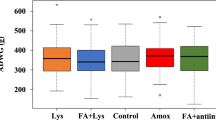Abstract
The influence of a probiotic additive and aromatic oils from medicinal and spicy plants on the basic production parameters and on the incidence of intestinal disorders of weaned pigs (weaning at the age of 30–32 days) was compared in two trials in a commercial pig fattening farm (Michalovce, Slovakia). In the first trial, an experimental (n ex = 38) and a control group (n co = 32) were used. A commercial probiotic additive containing Enterococcus faecium M-74 (6 × 108 CFU/g) and IgY antibodies (920 mg/g dried activated egg matter) against pig Rotavirus and different strains of Escherichia coli (K88, K99, 987P, F18) were added to feed mixture of the experimental group from 30th to 40th day (12 × 108 CFU/g) and subsequently from 40th to 50th day (6 × 108 CFU/g) of age. The second trial was performed with three groups of pigs (n ex1 = 28, n ex2 = 24, n co = 28). Aromatic oils isolated from sage (Salvia officinalis L., Labiateae) or oregano (Origanum vulgare L., Lamiaceae) were added to feed mixtures of the 1st (90 mL/100 kg) and 2nd experimental group (35 mL/100 kg), respectively, from 32th to 53th day of age. A statisticaly non-significant decrease of the incidence of diarrhoeal diseases was observed in the experimental groups of both trials as follows: in the 1st trial by 43.41%, whereas in the 2nd trial by 20.03% (1st exp. group) and 6.72% (2nd exp. group) in comparison with the control groups. The daily weight gains increased in the 1st trial by 42.95 g/day, while in the 2nd trial by 69.52 g/day (1st exp. group) and 105.23 g/day (2nd exp. group; p < 0.05) compared with controls.
Similar content being viewed by others
References
Bölcskei, A., Bilkei, G., Biro, O., Clavadetscher, E., Goos, T., Waller, C. & Stelzer, P. 1995. Management der E. coli-bedingten Faktorenkrankheiten nach dem Absetzen der Ferkel. Berl. Münch. Tierärztl. Wochenschr. 109: 108–111.
Bomba, A., Nemcová, R., Mudroňová, D. & Guba, P. 2002. The possibilities of potentiating the efficacy of pobiotics. Trends Food Sci. Technol. 13: 121–126.
Burt, S.A. & Reinders, R.D. 2003. Antibacterial activity of selected plant essential oils against Escherichia coli O157:H7. Lett. Appl. Microbiol. 36: 162–167.
Dorman, H.J.D. & Deans, S.G. 2000. Antimicrobial agents from plants: antibacterial activity of plant volatile oils. J. Appl. Microbiol. 88: 308–316.
Ewing, W.N. & Cole, D.J.A. 1988. Probiotics: theory and application pp. 39–45. In: Stark, B.A. & Wilkinson, J.M. (eds) Practical Applications of Probiotics in Livestock Production, Chalcombe Publications, Wye College, England, U.K.
Friedman, M., Henika, P.R. & Mandrell, R.E. 2002. Bactericidal activities of plant essential oils and some of their isolated constituents against Campylobacter jejuni, Escherichia coli, Listeria monocytogenes and Salmonella enterica. J. Food Prot. 65: 1545–1560.
Hammer, K.A., Carson, C.F. & Riley, T.V. 1999. Antimicrobial activity of essential oils and other plant extracts. J. Appl. Microbiol. 86: 985–990.
Janssen, A.M., Scheffer, J.J.C. & Baerheim-Svendsen, A. 1987. Antimicrobial activities of essential oils. A 1976–1986 literature review — aspects of the test method. Planta Med. 53: 395–398.
Kalemba, D. & Kunicka, A. 2003. Antibacterial and antifungal properties of essential oils. Curr. Med. Chem. 10: 813–829.
Knobloch, A., Pauli, B., Iberl, H., Weigand, H. & Weis, N. 1989. Antibacterial and antifungal properties of essential oil components. J. Ess. Oil Res. 1: 119–128.
Kolb, H. & Kolb, M. 2005. Aromatic substances in Animal Nutrition. Feed Magazine/ Kraftfutter 7–8/05: 16–19.
Kovac, B. & Bilkei, G. 2003. Oregano (Origanum vulgare) dietary supplementation increases the reproductive performance of sows. Folia Veterinaria 47: 207–209.
Pape, H.C. 2004. The market for additives in germany, slight decline in 2003. Feed Magazine/Kraftfutter 7–8/04: 232–235.
Rios, J.L., Recio, M.C. & Villar, A. 1988. Screening methods for natural antimicrobial products with antimicrobial activity: a review of the literature. J. Ethnopharmacol. 23: 127–149.
Schulman, A. 1973. Effect of weaning on pH changes of the contents of the piglet’s stomach and duodenum. Nord. Vet. Med. 25: 220.
Sikkema, J., De Bont, J.A.M. & Poolman, B. 1994. Interactions of cyclic hydrocarbons with biological membranes. J. Biol. Chem. 269: 8022–8028.
Smith-Palmer, A., Stewart, J. & Fyfe, L. 1998. Antimicrobial properties of plant essential oils and essences against five important food-borne pathogens. Lett. Food Microbiol. 26: 118–122.
Ultee, A., Kets, E.P.W. & Smid, E.J. 1999. Mechanisms of action of carvacrol on the food-borne pathogen Bacillus cereus. Appl. Environ. Microbiol. 65: 4606–4610.
Wald, C. 2004. Phytobiotics in animal nutrition. Feed Magazine/Kraffutter 5/04: 136–140.
Wallace, R.J., McEwan, N.R., Mcintosh, F.M., Teferedegne, B & Newbold, C.J. 2002. Natural products as manipulators of rumen fermentation. Asian-Australasian J. Anim. Sci. 15: 1458–1468.
Wheeler, G.E. 1995. Effect of herbal livol on performance enhancement in fattening swine. Ind. J. Indig. Med. 17: 87–89.
Yadava, J.N.S., Gupta, S., Ahmad, I., Varma, N. & Tandon, J.S. 1995. Neutralization of enterotoxins of E. coli by coleonol (foskolin) in rabbit and guinea pig ileal loop models. Ind. J. Anim. Sci. 65: 1177–1181.
Author information
Authors and Affiliations
Corresponding author
Rights and permissions
About this article
Cite this article
Marcin, A., Lauková, A. & Mati, R. Comparison of the effects of Enterococcus faecium and aromatic oils from sage and oregano on growth performance and diarrhoeal diseases of weaned pigs. Biologia 61, 789–795 (2006). https://doi.org/10.2478/s11756-006-0159-9
Received:
Accepted:
Issue Date:
DOI: https://doi.org/10.2478/s11756-006-0159-9



